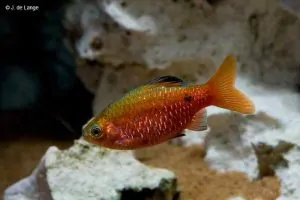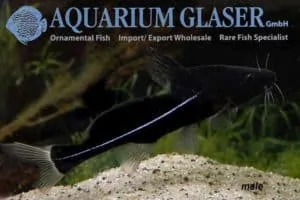Danio margaritatus – Rasbora Galaxy – Pearl Danio
Danio margaritatus was officially described by Roberts in 2007. He described the species as Celestichthys margatitatus. However, more recent research showed that this species actually belongs to the genus Danio. Therefore, the official scientific name is Danio margaritatus. In Latin, margaritatus means: decorated with pearls. This refers to the white spots that can be found on the body of these fish.
This reference can also be found in the common name, which is: Celestial Pearl Danio or simply Pearl Danio.
Synonym: Celestichthys margaritatus.
Description
The body of Danio margaritatus is green-blue to dark blue in color. In addition, white spots can be seen on the body. These white spots are the “pearls” mentioned above. The belly of these fish is bright red just like the fins. A black stripe pattern can be observed on the fins themselves. The caudal fin is an exception to this. The basic blue color of the body blends into this as a kind of stripe. However, the tips of the fin are bright red again.
They can reach a total length of between two and three centimeters. So make sure that the tankmates are not too large, otherwise the Rasbora Galaxy will quickly become food for the other fish.
Gender distinction can be made by looking at the colors of the fish. males often have brighter colors. The blue color in particular is a lot darker in females than in males. The spotting pattern in females also extends less far onto the abdomen.

Distrubution and Habitat
Danio margaritatus is mainly known from its original location in Myanmar. They can be found here in small pools. These pools have very clear water and the measured temperature in January was between 22 and 24 Celsius. In addition, they are also quite shallow. Most pools have a depth of only 30 centimeters. The ponds are located in an open grassland. They are formed by springs or overflowing streams. Many plants also occur in the water. The specimens found come from the genus Hydrocharitaceae. This includes Elodea and Anacharis species.
Diet
In nature, the Celestial Pearl Danio probably lives on small insects and their larvae. They will also probably eat zooplankton.
Specimens bred in captivity usually eat flake food. Nevertheless, it is advisable to occasionally feed frozen or live food. This is especially true for Daphnia and brine shrimp. This food ensures that the fish get a nice color.
Danio margaritatus specimens that come from the wild are a lot more difficult to get them to eat. It is therefore advisable in this case to first give them live food and slowly accustom them to dry food.
The Aquarium
These Danios are very shy compared to other larger fish species. This can prevent the Danios from getting enough food. Therefore, do not keep them with large or dominant fish species.
The Danio margaritatus can be quite aggressive with each other. Often the males will show off and chase each other. Torn fins are therefore more of a rule than an exception. The real damage from mutual aggression can be prevented by having a large school. The bigger the better. This way, the aggression is better distributed between the fish. This allows all fish to rest occasionally and not one fish is constantly the victim.
An aquarium from 60 centimeters is sufficient for this small fish. Provide dense planting between which they can take shelter and leave some swimming space open in the middle. This schooling fish performs best in a school of 10 or more. Better yet is a much larger school.
Breeding Danio margaritatus – Rasbora Galaxy
Breeding the Pearl Danio is best done in a separate breeding aquarium. This can be decorated with many fine-leaved plants, especially Java moss. The fish lay their eggs in these plants. In addition to plants, you can also choose to put spawning mops in the aquarium. The fish will also like to lay their eggs here.
After setting up the breeding aquarium, first, let it run so that it has time to mature. In a mature aquarium, there is always some super-small food available for the fry. Now place the parents in the breeding aquarium. Please note that you only place a number of fish. The more Danio margaritatus there are in the aquarium, the greater the chance that many eggs will be eaten. For the same reason, the parents must be removed when the eggs have been laid.
The females lay up to 30 eggs at a time. These are approximately 1 millimeter in size. This is slightly smaller than the dots on the flanks of the fish. After 3 to 4 days the young will hatch from the egg. Another four days later the fish will start swimming around freely. They will then initially feed on micro-organisms. Give the fry additional food in the form of infusoria and very fine dust food. Only when the fry are a bit older can they eat Artemia nauplii or microworms. When the fry are about 12 weeks old, the color pattern of the adult fish will begin to appear. In the wild, the fish probably spawn all year round.
Also read Michael Pham’s breeding report
Video
Author
Rick – LauMooij – J. de Lange
Copyright images
Hristo Hristov
Gerry Verrier
Yabby
Resources
Roberts, T. R. (2007). The “celestial pearl danio”, a new genus and species of colourful minute cyprinid fish from Myanmar (Pisces: Cypriniformes). The raffles bulletin of Zoology, 55(1), 131-140.
Fishbase
Seriouslyfish.com

























Reviews
There are no reviews yet.